Talent Acquisition: Tips for Finding and Onboarding the Right Talent
Let’s be real – building a high performing creative or marketing team isn’t for the faint of heart. Between sourcing, screening, onboarding, managing personalities, and trying to get actual work done… It’s a lot.
And hiring the wrong people? That’s how timelines go sideways, budgets evaporate, and suddenly everyone’s asking, “how did we end up here?”
That’s usually when it happens – right as key deadlines creep closer – someone inevitably throws out the classic exec line: “Can’t we just bring in freelance talent?”
Sounds simple enough – until you’re the one scrambling to find someone who’s actually available, talented, and able to get up to speed quickly.
And you’re not alone. We ran a quick poll with studio and creative leads to see what the biggest pain points are when bringing in flexible talent? The verdict?
- Finding the right fit takes the top spot.
- Getting people ramped up comes in hot at number two.
- And rounding out the top three: “It’s always more work than expected.”
No surprise there.
That’s exactly why we built Sandy – to take the weight off your shoulders and make the whole process easier. After years of helping brands find, vet, onboard, and manage amazing talent, we’ve picked up a few tricks (and a few battle scars) along the way.
Here’s our no-fluff guide to doing it smarter:

We all say we’ll plan better next time – but do we? So before the fire drill hits, ask yourself:
- Where are the gaps coming up?
- What skills will you need next quarter (not next week)?
- Who’s actually responsible for finding the right people?
- And are we set up to get them onboarded and rolling fast?
And if you’re bringing in outside help, get those vendor approvals done. The last thing you want is red tape when your team is already underwater.
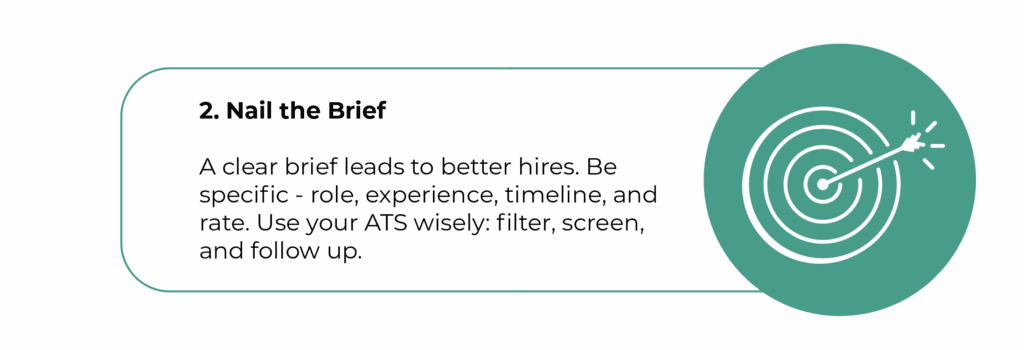
A great brief gets great work. The same rule applies to hiring.
Whether it’s full-time or freelance, get specific. Spell out the role, required experience, timeline – and yes, the rate. (Transparency now = fewer headaches later.)
If you’re using an ATS, treat it like a partner, not a dumping ground. Add smart filters. Ask qualifying questions. Automate the “no thanks” replies. A thoughtful process shows your values – even to the folks who don’t get the role.
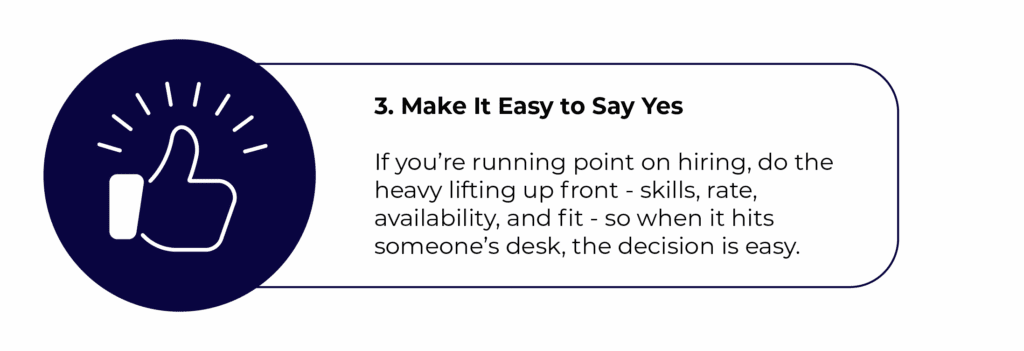
We don’t toss you 73 resumes and wish you luck. We hand-pick a few great people from our network – or go recruit them if it’s a unicorn hunt. Every candidate is screened for skill, rate, availability, and culture fit before they ever hit your inbox.
If you’re the one leading the hiring charge, your job is to make the decision-making easy for stakeholders:
- Skillset? Check
- Availability? Check
- Rate + location? Check
- Culture fit? Check
When it’s all laid out clearly, saying “yes” (or “no”) becomes the easiest part of the process.
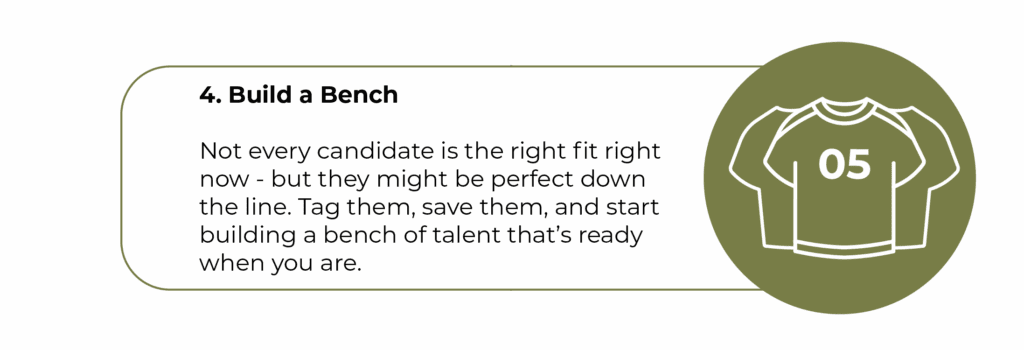
We’ve talked about this before. Don’t think one-and-done. Not everyone you interview will be a fit right now – but they might be perfect later. Take good notes. Standardize your process. Tag candidates with helpful keywords. Save them somewhere smart.
Because when that “oh sh*t” moment hits, you’ll want your bench ready.
Think of it like your creative special teams: UXers, copywriters, motion designers – all warmed up, vetted, and ready to jump in when you need the extra support.
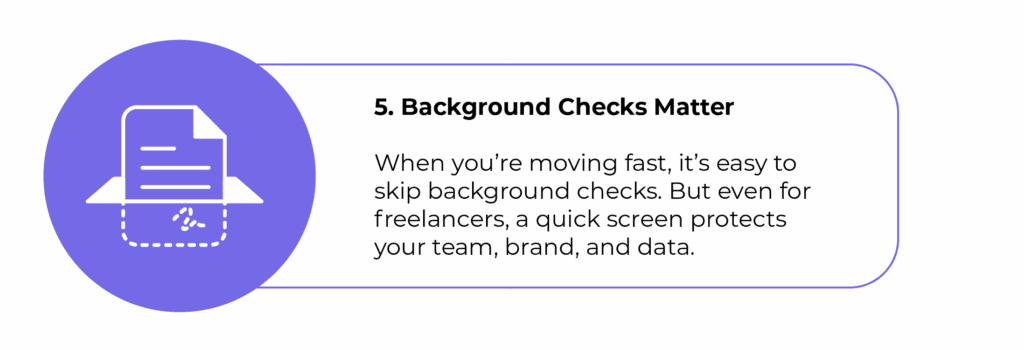
We get it – when you’re under the gun to fill a gap, it’s tempting to skip steps. But don’t skip the background checks.
Even for freelance or contract roles, a quick screen can save you a world of trouble. You’re giving this person access to your brand, your team, and sometimes sensitive tools or data. A check helps verify who they are, confirms experience, and flags any potential issues – without slowing down the process.
It’s not about being overly cautious. It’s about being smart. You’d vet a full-timer. Do the same for your flexible talent.
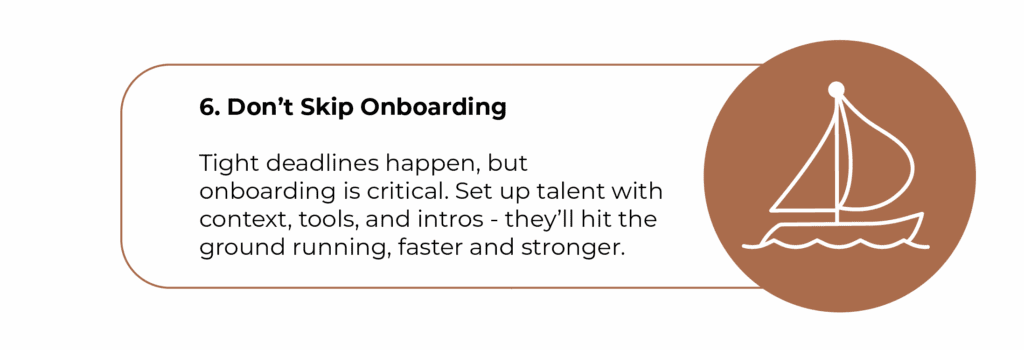
We know, the deadline is tight. But onboarding isn’t optional. Even the best talent needs context to thrive.
If you want someone to start strong, you’ve got to set them up right:
- Contracts + payroll
- Time tracking + tools access
- Systems + process
- Brand guidelines, briefs, templates
And definitely a team intro and Slack shoutout so they don’t feel like a ghost in the machine.
Remember: Slow is smooth. Smooth is fast.
Take the time up front, and you’ll have someone who’s confident, efficient, and able to deliver real value in no time.
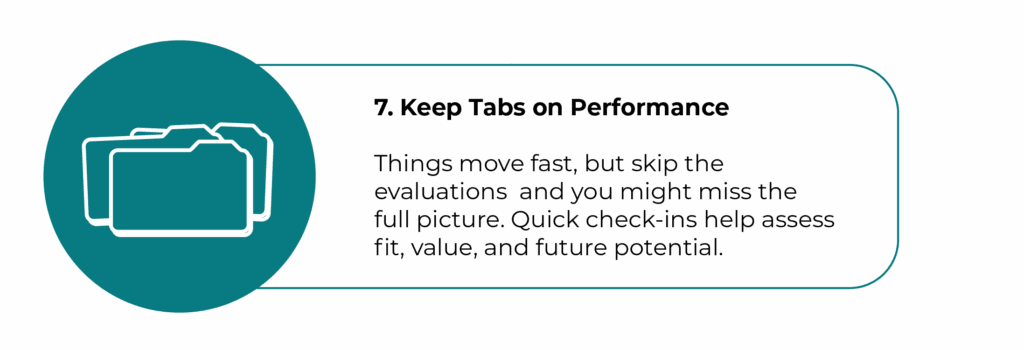
Look, we get it – things move fast, and reviews can feel like one more thing on the to-do list. But if you want to know whether your new team member is actually driving value, you’ve gotta go beyond just “feel”.
Yes, you can assess on the fly by looking at deliverables, but a quick 360’ check-in can give you the full picture. That means feedback from you, the team they’ve been working with, and the talent themselves. What’s working? What’s not? What would you do differently next time?
This isn’t just about improving for the future. It’s also the first step in building your talent bench. Once you’ve seen someone in action and collected real insights – good, bad, or somewhere in between – you’ll know exactly how (or if) to plug them back in when the next need rolls around.
There’s a lot more we could say on each of these points – but if you want to get the most out of your flex talent, it really comes down to this: take the time.
Whether you’re hiring full-time or bringing in rockstar freelancers, the same rules apply:
- Plan ahead
- Communicate clearly
- Be transparent
- Sweat the small stuff
- Set people up to succeed
- And always, measure what’s working – and optimize for what’s next.
At Sandy, we help fill creative and marketing gaps with flexible, high-performing talent. We’ve been through the pain points above (more than once), and we’ve built our process to make things easier for you.
Curious how it all works? Please feel free to reach out – we’d love to chat.
